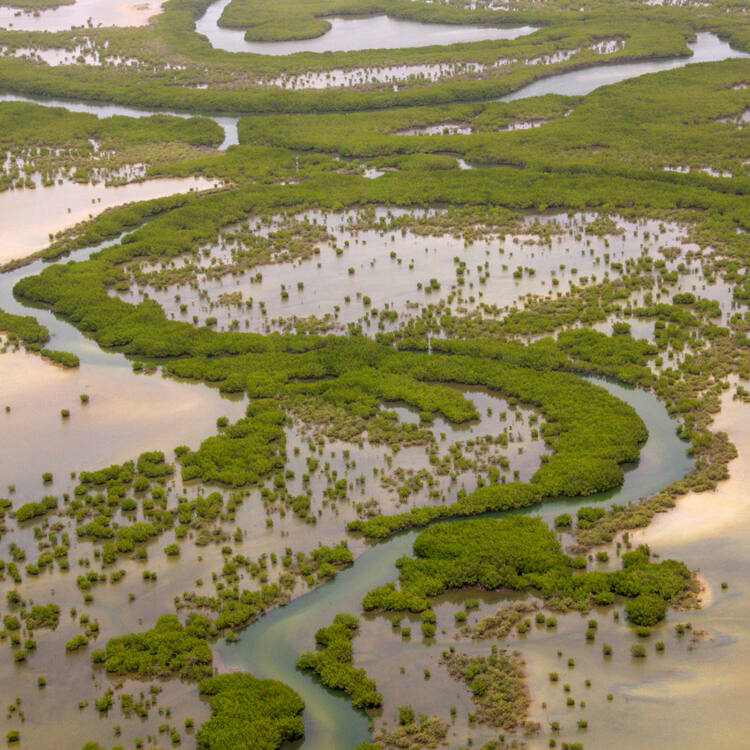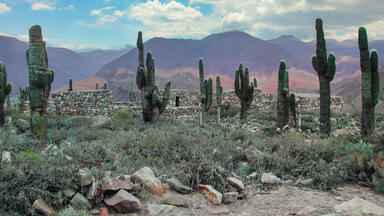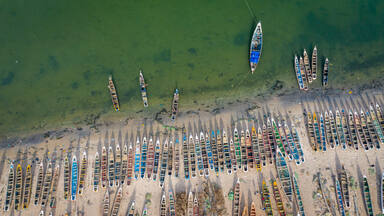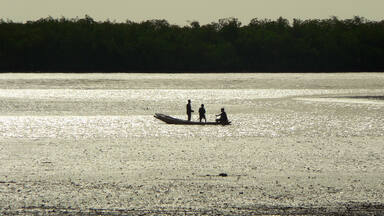Saloum Delta
Saloum Delta
Fishing and shellfish gathering have sustained human life in the 5,000 km2 property, which is formed by the arms of three rivers. The site comprises brackish channels encompassing over 200 islands and islets, mangrove forest, an Atlantic marine environment, and dry forest.
The site is marked by 218 shellfish mounds, some of them several hundreds metres long, produced by its human inhabitants over the ages. Burial sites on 28 of the mounds take the form of tumuli where remarkable artefacts have been found. They are important for our understanding of cultures from the various periods of the delta's occupation and testify to the history of human settlement along the coast of West Africa.
Description is available under license CC-BY-SA IGO 3.0
Delta du Saloum
La pêche et la cueillette ont fourni des ressources vitales aux communautés humaines sur ce bien de 5000 km², formé par les bras de trois fleuves. Le site englobe des canaux d'eau saumâtre et près de 200 îles et îlots, des mangroves, un environnement maritime Atlantique et une zone boisée sèche.
Le bien est marqué par 218 amas coquilliers, dont certains font plusieurs centaines de mètres de long, qui résultent de l'activité humaine au cours des millénaires. Sur ces amas coquilliers, on dénombre 28 sites funéraires en forme de tumulus. Des objets remarquables y ont été découverts, ce qui devrait permettre une meilleure compréhension des cultures associées aux différents âges de l'occupation du delta et témoigner sur l'histoire de l'occupation humaine le long des côtes de l'Afrique de l'Ouest.
Description is available under license CC-BY-SA IGO 3.0
萨卢姆河
source: UNESCO/CPE
Description is available under license CC-BY-SA IGO 3.0
На территории площадью в 5000 кв. сохранились следы человеческой деятельности – в основном, рыболовства и сбора моллюсков. Объект включает три рукава реки, солоноватые каналы, омывающие более 200 островов и островков, мангровый лес, атлантическую морскую среду и сухой лес. Территория замечательна своими скоплениями раковин моллюсков и останков ракообразных, некоторые из 218 холмов, образованных этими скоплениями, имеют протяжённость в несколько сот метров и возникли в результате человеческой жизнедеятельности в течение тысячелетий. Замечательные артефакты были найдены в 28 курганах, отмечающих места захоронения. Они имеют большое значение для лучшего понимания культуры, сложившейся в различные периоды обитания здесь людей, и свидетельствуют об истории человеческих поселений вдоль побережья Западной Африки.
source: UNESCO/CPE
Description is available under license CC-BY-SA IGO 3.0
Delta del Salum
Durante milenios, la pesca y la recolección de moluscos han proporcionado medios de subsistencia al hombre en esta superficie de 5.000 km2. Formado por los brazos de tres ríos, el sitio comprende una red de canales de agua salobre con más de 200 islas e islotes, bosques de manglares, zonas costeras atlánticas y un bosque seco.
Otra característica notable de la zona es la presencia de 218 montículos formados por valvas de moluscos como resultado de la actividad humana. Algunos alcanzan una longitud de varios centenares de metros. En 28 de esos montículos hay sitios funerarios en forma de túmulo, donde se han hallado objetos artesanales de factura notable. Estos objetos son importantes para un mejor conocimiento de las culturas correspondientes a los diferentes periodos de ocupación del delta por el hombre y constituyen un testimonio de la historia de los asentamientos humanos a lo largo de la costa del África Occidental.
source: UNESCO/CPE
Description is available under license CC-BY-SA IGO 3.0
サルーム・デルタ
source: NFUAJ
Saloum delta
De Saloum delta bestaat uit brakke kanalen die meer dan 200 eilanden en eilandjes, mangrovebossen, een Atlantische mariene omgeving en droog bos omvatten. Dankzij visserij en het verzamelen van schelpdieren kon de mensheid zich in stand houden in het 5.000 vierkante kilometer grote gebied. Het deltagebied wordt gekenmerkt door 218 terpen bestaande uit restanten van schelpdieren, door de eeuwen heen geproduceerd door menselijke bewoners. 28 van de terpen hebben de vorm van grafheuvels, waar opmerkelijke artefacten zijn gevonden. Ze zijn belangrijk voor ons begrip van de culturen uit verschillende periodes die in de delta voorkwamen en ze getuigen van de geschiedenis van menselijke bewoning langs de West-Afrikaanse kust.
Source: unesco.nl
Outstanding Universal Value
Brief synthesis
The region of the Saloum Delta is a remarkable testimony to the synergy between a natural environment with extensive biodiversity and a style of human development that is still present albeit fragile. Sustainable shellfish gathering and fishing practices in brackish water, and the processing of the harvest for its preservation and export was developed here. The shell mounds and the tumulus mounds form specific and exceptional cultural landscapes.
The numerous shell mounds in the Saloum Delta are generally well-preserved and they sometimes have imposing dimensions. They are direct testimony of sustainable and very ancient socio-economic practices. Over the centuries, they have led to the formation of numerous man-made islets contributing to the stabilisation of the delta's land and channels. With their characteristic vegetation within the delta's natural environment, the shell mounds form typical cultural landscapes. Some mounds include tumuli; they form, with their baobab vegetation and their undulating forms, funerary sites with specific landscape features.
Criterion (iii): With its numerous shell mounds, associated landscapes and the presence of a rare and well-preserved ensemble of funerary tumulus mounds, the Saloum Delta provides exceptional testimony to a coastal lifestyle, in a Sahelian subtropical environment, with brackish water rich in shellfish and fish.
Criterion (iv): All the shell mounds built up over a 2,000 year-long cultural process have formed a physical structure of stable islets and reclaimed land within the Saloum Delta. The resultant cultural landscapes are exceptional and illustrate a long period of the history of human settlement along the West African coast.
Criterion (v): The Saloum Delta is an eminent example of traditional human settlement. It represents a lifestyle and sustainable development based on the gathering of shellfish and fishing, in a considered interaction with a natural environment of extensive but fragile biodiversity.
Integrity
The conditions of cultural integrity of the Saloum Delta are in theory very adequate, even if some shell mounds have been damaged, but the integrity remains fragile. The shell mounds and the cultural landscapes and the biodiversity of the natural environment may be threatened by poorly controlled socio-economic behaviour.
Authenticity
The conditions of authenticity of the mounds, tumulus mounds and their landscapes are generally adequate. They are complemented by the anthropological authenticity of the shellfish gathering practices and to a lesser degree of the fishing practices.
Protection and Management requirements
The protection of the shell mounds and the tumuli mounds is ensured by adequate regulatory measures. However, the active protection of the cultural sites in the field is recent and must be extended to the property as a whole, and not just concern the National Park. Additionally, the general policy for the property's conservation is closely tied to the conservation of the natural environment and the sustainable development programmes for the delta as a whole.
The property's management relies on numerous individuals in the field. Together they form an adequate management system for the property, with the key stakeholders and those in charge clearly identified, notably the National Park, the rural communities and the United Nations MDG-Fund. However, this management system is evolving and the multiplicity of programmes and stakeholders tends to make some situations somewhat confused. The overall management committee still has to be set up (2011), its resources confirmed, and the homogeneous handling of management and conservation for the entire property needs to be improved.



